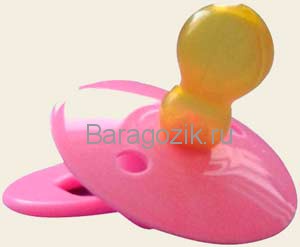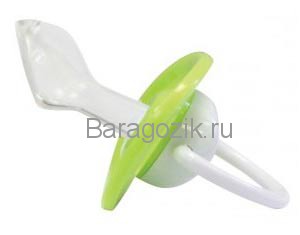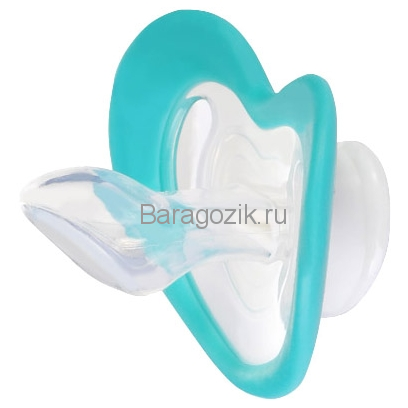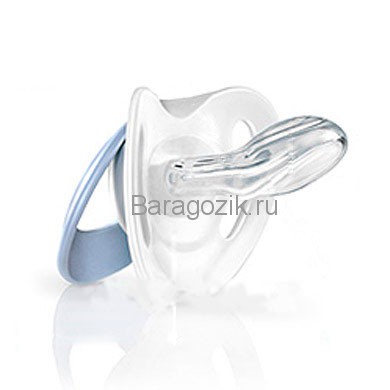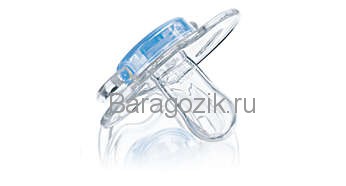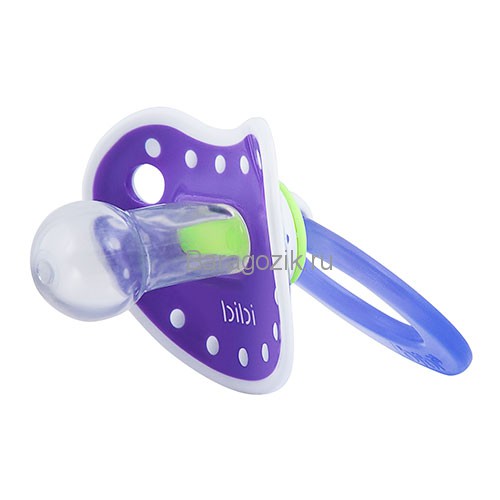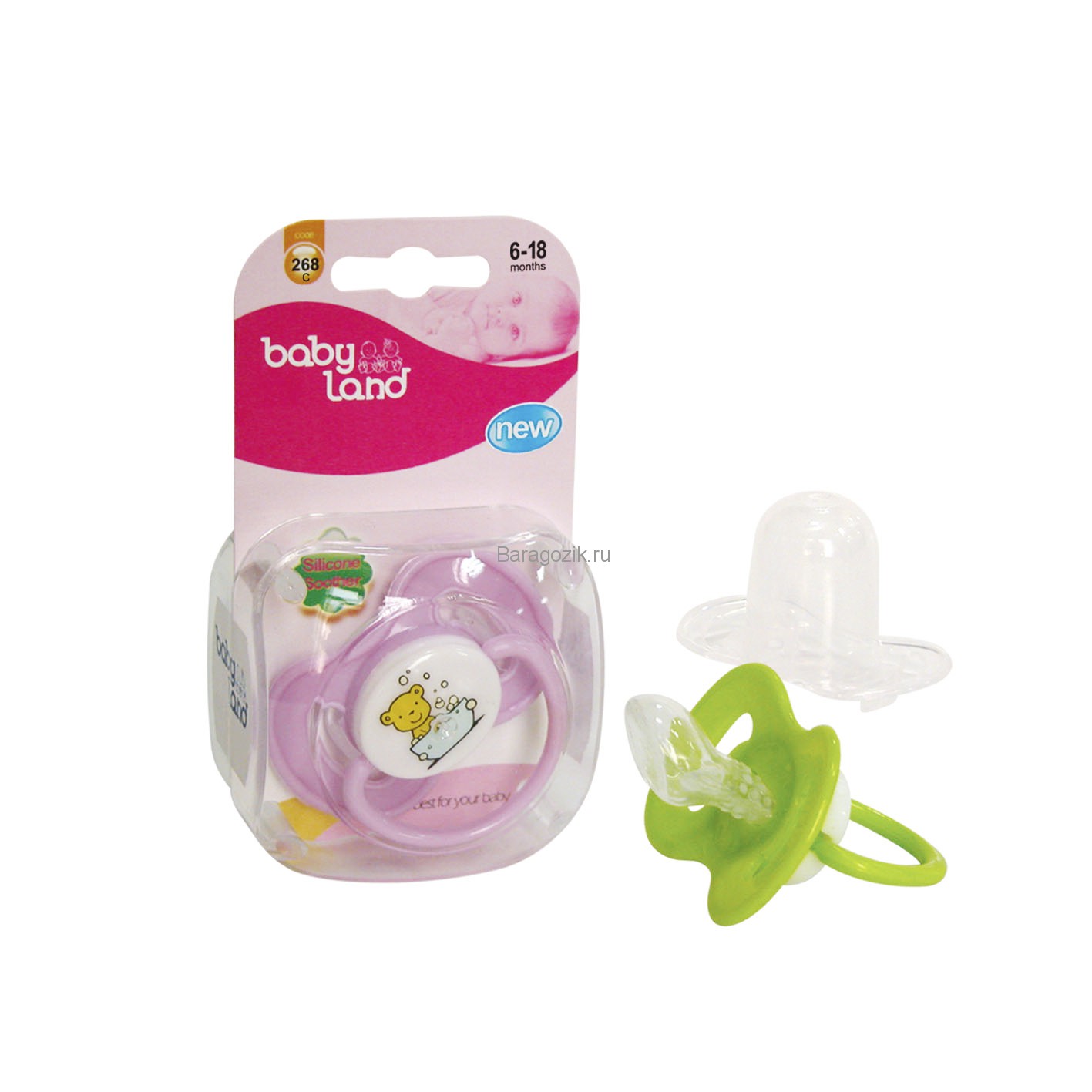The history of dummies of modern construction began in 1900. The inventor of the first pacifier, made of rubber and equipped with a plastic holder, was Christian Meineke. Disputes about the pros and cons of the use of pacifiers are ongoing among professionals and moms. In the article we will consider the advantages and disadvantages of using pacifiers, their classification, popular models of pacifiers.
Do I need a dummy for a newborn - the advantages and disadvantages of using nipples
The use of pacifiers often causes controversy associated with the quality care of the crumbs. The solution to this issue must be approached wisely and not go to extremes. If the crumb with pleasure takes the nipple in the mouth, do not deprive him of a kind of "relaxation", but if he resists sucking the pacifier - do not force the child.
Important!
The advantages of using pacifiers:
- Satisfaction sucking reflex. The first reflex that appears in the baby is sucking. This reflex must be fully satisfied. When the baby sucks her mother's bosom on demand and does not have a lack of feeding, he can also ignore the nipple, since his needs are met.
- By sucking a pacifier, the baby feels some kind of security. which is accompanied by calmness, good mood, the crumb is much better sleeping.
- Doctors noted that when a baby uses a pacifier while sleeping, by 30% reduced risk of sudden death syndrome (CBC) . To date, this phenomenon is shrouded in mystery and is the biggest nightmare for parents.
- The use of nipples helps to strengthen the muscles of the oral cavity in an infant . Especially the sucking reflex needs to be developed in premature babies, because it has been proven that by sucking the pacifier they gain weight faster.
- Dummy "lesser evil" than a child's finger. In the end, the baby's dummy can be thrown out and the child will get used to the idea that the nipples are gone, and if the pussy likened his finger - this is where the real problem lies, since it is harder to wean such children from this process.
Disadvantages of using pacifiers:
- Do not give a newborn pacifier at least 1 month of age, otherwise can completely break the GW. Also, it is worth to wait a little with a dummy if the baby does not feel the difference between the nipple and the breast. He must understand that the breast is a source of nourishment and energy, and a dummy - only to satisfy the sucking reflex. First you should, and then apply the nipples.
- Children are addicted to pacifiers. In most cases, they get used to the nipple, and this often leads to the fact that parents wake up in the middle of the night from loud crying crumbs, which dropped the nipple from the mouth and felt discomfort.
- Dummy is dangerous if parents do not follow the rules of hygiene. Due to a microbial, non-boiled nipple, a child may have dysbacteriosis or an infection may enter its body. Therefore, you need to carefully monitor what kind of nipple you give him and regularly boil it.
- If the mother didn’t correctly pick up the pacifier for her baby or the nipple just doesn’t fit him, may cause early.
- The bite of the child is formed long before the appearance of the first teeth. BUT nipple interferes with the formation of teeth and proper bite.
Each parent decides to give the child a pacifier or not. But if you decide to use the nipple, do not tighten up with this process, because the baby needs a pacifier only in the first year of life. After a year, the use of dummy is not harmless to the baby.
Which dummy is better: the types of nipples in shape, material, size
If you decide to purchase a pacifier, then you need to competently approach the purchase of this product, since the nipples differ in shape, size and material. The tables below provide a nipple classification to help parents identify the correct dummy model.
Varieties of pacifier shape
| Types of dummies in form | pros | Minuses |
| Classic - remind old-style pacifiers with a rounded nipple.
|
You can give the baby a pacifier any convenient side. It is convenient for the child to suck, as the form resembles the mother nipple. |
With constant use may develop an incorrect bite in the baby. |
| Anatomical - have an oblong, oblate nipple.
|
Have a different size, you can choose the appropriate option for the weight of the baby. The form corresponds to the structure of the baby's gums, so it is convenient for him to use it. Such a dummy evenly distributes the pressure on the sky of the child. Develops the correct bite, does not allow to swallow excess air. |
Only personal dislike of the child to the shape of the anatomical nipples. |
| Orthodontic
there are several types:
Cherry - for kids with a big sky.
Butterfly- for babies who love to sleep on the tummy.
Heart- For the formation of the correct bite.
|
Dummy-cherries are the most popular, as their teardrop-shaped form is most organic for baby mouth. The baby captures the nipple, as her mother's breast, so he is more calm for a long time. The nipple reduces the risk of tooth deformities. | Some children do not perceive this type of pacifier, but in very rare cases. |
| Dummies with a protective disk
. Designed to protect against swallowing nipples.
|
The protective disk protects the baby from improper sucking the pacifier. | The disc can be heavy and fall out of the baby’s mouth. Sometimes plastic is attached to the mouth. In this case, it is better to buy solid discs with a pimply “breathing” structure, so that the baby does not have irritation and does not accumulate drool. |
Types of nipples, depending on the mother
| Types of pacifier type material | Features / Pros / Cons |
| Latex | Latex soother is made of rubber, because it is so elastic and flexible. Well suited to newborns, and is also indicated for premature or weak babies. Latex is short-lived, it can not be boiled, it gets dark in the sun, with constant use it increases in size. Sometimes latex causes allergies due to the content of protein molecules. It is necessary to change a pacifier from such material every month. |
| Rubber | This material is slowly becoming a thing of the past. It is short-lived and can cause diathesis on the cheeks of babies. But when teething teeth, rubber pacifiers will be very useful. |
| Silicone | Silicone soothers are made of synthetic material. They are more temperature resistant (amenable to boiling) than latex. They are odorless, have a transparent color, anti-allergenic. However, silicone is harder in structure, so when a tooth appears, you need to replace the silicone nipple with latex or rubber, in order to avoid the deformation of milk teeth. You need to change the nipple every 5-6 weeks. |
| Dummy categories by size | Features / Pros / Cons |
| Category A (from 0 to 6 months) | Designed for newborns and has a small form. The downside is that you will not use such dummies for a long time, since with an increase in the mass of the crumbs, you need to use a different size of the product. There is a category for premature. Some manufacturers produce a line of such pacifiers with an indication of weight less than 1,750 kg. |
| Category B (6 to 18 months) | Usually, the manufacturer always indicates the age at which the dummy is calculated, but children develop differently and you may not guess with the size. |
| Category C (over 18 months) | This category is not so relevant, as parents are trying to wean their children at that age. The downside is that if a mom needs a nipple of this size, it is harder to find on the shelves. |

Review of the best baby's dummies
Popular pacifiers: price, features, pros, cons
| Dummy Manufacturer | price, rub. | Special features | Advantages and disadvantages |
| Nuk genios
|
280 | German brand for the manufacture of physiological pacifiers. Patented product. | Orthodontic pacifier, soft and elastic. Safe for the child's body. |
| Pigeon
|
150 | Japanese brand of natural nipples for babies. | An inexpensive brand of orthodontic pacifiers. Beautiful design and hypoallergenic material are the main advantages of the dummies of this manufacturer. Of the minuses: recommended for children only up to 4 months. |
| Phillips avent
|
260 | English manufacturer of high-quality pacifiers for babies. | Dummy have vents at the mouthpiece, which prevents irritation around the mouth. It has an anatomical shape for the crumbs mouth. |
| Hevea
|
390 | Rubber, latex pacifiers High Quality. | Pros: a large assortment. There are beveled, round, orthodontic forms of pacifiers. There are ventilation holes. Minus: expensive cost. |
| Bibi
|
290 | Silicone soothers. | Quality nipples for the little ones. Minus: some children are allergic to the composition of silicone. Expensive and small ventilation holes. |
| Canpol babies
|
120 | Polish brand of inexpensive pacifiers. | The manufacturer manufactures pacifiers of different size and material. You can choose the desired option. The presence of the air valve, reasonable price, quality material - the advantages of the dummies of this brand. |
| Baby land
|
150 | Silicone soothers of different sizes. | The brand is famous for its low cost and quality. The only negative is the material that is not suitable for every kid. |
| Chicco
|
270 | Soft, anatomical, comfortable pacifiers. | Pros: functional pacifiers, in 98% fit the child (not rejected by him), high-quality nipple, reliable design. Minus: normal, unpretentious design, latex will not last long. |
- To choose a good and high-quality dummy, it is not enough to pay attention only to the brand and price. Focus on the preferences of the crumbs and their needs. Pay attention to the position in which your baby is sleeping. For example, it is better to purchase a dummy butterfly if the baby is sleeping on its stomach. And if your baby has a big mouth, then without a doubt buy a “cherry”.
- Focus on the age and weight of the crumbs , then it will be easier to pick the right dummy.
- Give preference to hippoallergenic nipples , especially when choosing a product for a newborn.
- Try to buy several options for baby dummies. Let it be a budget brand, but you can find a suitable model with less loss, and then, if you wish, buy a well-known brand with a bright and colorful design of the soothers.
Opinions of experts: whether to give a pacifier
Doctor Komarovsky:
Very interesting thing, allowing the child to satisfy his sucking reflex and not interfere with the mother. The thing is interesting, but not at all obligatory - it does not want, and it is not necessary, you can even say this: it doesn’t, well, very well. For any problems with the amount of mother's milk, the use of pacifiers is undesirable.
If you do not make a cult from a pacifier, then you can accustom the baby to it, because some children want to satisfy their sucking instinct, even after a hearty lunch, when they are completely saturated. Children follow their instincts, so it’s not good to save them from this process.
Opinion of the breastfeeding adviser G. Eltonskaya:
Someone gets to live with a dummy, someone - no. And it does not work for a much larger number of mothers! When using a dummy, attachment definitely suffers. Those. sucking quality. For some, this translates into steep chest problems, for someone, nothing. In addition, there may be problems with the health of the child - the back milk contains immunoglobulins, and the child loses them with poor sucking. In addition, he lacks the enzymes necessary for digestion, with all the ensuing problems.
Using a dummy often leads to psychological problems: it can interfere with the establishment of a deep emotional connection between the infant and his mother. Wrote about it psychoanalysis classic Donald Woods Winnicott :
A part of love, affection, gratitude, intended for mother, are automatically transferred to the object that replaces her breast - with a bottle or a pacifier. If they provide a feeling of safety when falling asleep, console in a difficult moment, help to survive fear and discomfort, then mother is perceived as very consumer - only as a supplier of food, and not an object of deep and trusting relationships. Offering the pacifier in response to a request to attach itself to the breast, the mother herself refuses the tenderness that her long-awaited baby wants to give her, thereby further alienating him from herself.
Y. Palchevskaya, consultant for GW:
The use of soothers is justified only occasionally, during the absence of the mother and in the absence of another opportunity to calm the child. In addition to the psychological moments, the baby's dummy almost always provokes the wrong grip of the breast. Sucking even an orthodontic pacifier can cause the formation of improper bite, as well as, subsequently, speech defects.
W. and M. Serz in their book "Your Child" write:
Dummy or finger: which is better?
We vote for the finger. It is easy to find him in the middle of the night, he does not fall to the floor, he tastes better when the child wants to suck, he has what. Nipples are lost, dirty, they are constantly falling to the floor. Opponents of thumb sucking can say that, weaning a baby from the nipple, it is easier to lose it than a finger. Indeed, intensive thumb sucking for three to four years can lead to abnormal tooth growth. Parents of tiny flukes fingers, do not rush to look for an orthodontist. All children suck a finger for a while. Most safely pass this stage, and if the sucking instinct was satisfied in infancy, the habit of sucking on a finger is forgotten. (...)
Our advice: in the first weeks in the mouth of the child should be only mother's nipple. If your child really needs a nipple, use it, but do not abuse it, and try to get rid of it quickly.
Many children require nipples, both as a sedative and as a means of development and formation of the maxillofacial apparatus. Some children need a mother’s breast for this, and others need dummies in addition. An orthodontic dummy in this case is a wonderful tool. Along with the development of the lower jaw and calming the child, the orthodontic soother also forms the correct bite. This is her direct appointment.

· Orthodontic dummy: what is the difference?
In addition to the size and materials of manufacture, the pacifier for the child can be different in form papilla:. Anatomical nipple for children has an elongated or oblate ellipsoid papilla. Such a baby’s dummy distributes the pressure throughout the oral cavity evenly.
In orthodontic anus, papilla oblique. It is considered that the orthodontic pacifier in the oral cavity is more convenient and for the child to grip it, it is necessary to carry the upper jaw forward as well as when grabbing mother's breast. Thus, the baby's nipple stimulates the development, growth and strengthening of the lower jaw, the correct formation of the temporomandibular joint takes place, in other words, the right bite. Practically all children are born with the location of the lower jaw a little deeper, as if behind the top. And this is considered the norm, in medicine it is called infant retrogeny. By about 6-8 months, this discrepancy between the jaws should disappear. Jaws self-regulation occurs due to active sucking, during which the child's lower jaw is pushed forward - this is how the correct bite is formed.
· What are orthodontic pacifiers?
The shape of an orthodontic soother can be:
1. heart - for the formation of bite;
2. butterflies - suitable for lying baby on the tummy;
3. cherries - Dummy recommended for kids with a big sky, so to speak specifically for the "heroes".
According to the composition of the material dummies are divided into:
- orthodontic latex soothers - these are natural (rubber), environmentally friendly nipples for children, very soft and elastic. This baby nipple is ideal for only newborn babies, it is recommended for weak and premature babies. The main disadvantage of the latex pacifier is the specific smell and taste, which may not like the toddler. In addition, the composition of the latex may be protein molecules, which for some kids is an allergen;
- orthodontic Silicone Soothers - These are “artificial” nipples made of silicone, that is, fully synthetic. They have neither smell, nor taste, and do not cause an allergic reaction. Unlike latex, silicone baby nipple is stronger and more durable.
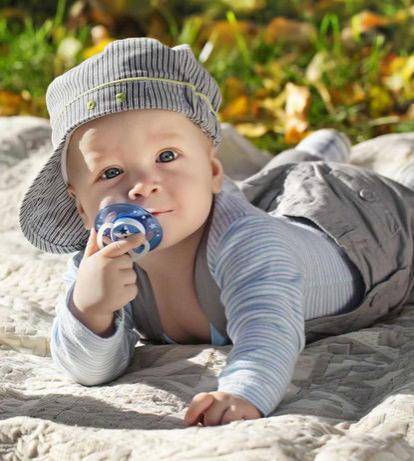
· How to give a dummy child?
After hearing the advice of "lovers to teach," often young parents come to a stupor from the question: "How to give an orthodontic pacifier correctly?". We explain.
Till 6 months mummy can not worry and boldly give a pacifier to a child. But do not particularly zealous, the baby's nipple, of course, forms the correct bite, but at the same time the bad habit, which can later spoil this most correct bite. Mom generally should not poke a baby in the mouth with a pacifier, if she does not have lactation. First you need to deal with your breasts. An undernourished baby may treat it as a “food self-deception” method: when you want to eat, saliva is produced more actively, swallowing it while sucking the nipples, the child may begin to lose his appetite, and will become constantly undernourished.
Nature has given children a sucking reflex, not only for food, mother's breast and nipple for children - it is also a kind of sedative. I think any mommy knows when the baby’s dummy is lost, he starts crying and acting up until he is lost. That is why it is so difficult to wean a child from the nipples - often babies react to this as if it were a real tragedy. But in the end, this is also a matter of habit.
If you carry on feeding at the request of the baby, that is, a day to put it on the chest 10-12 times, then suck enough for him breast milk, baby alone and quickly falls asleep. For the formation of a normal bite, and this will be enough, with such feeding to give a pacifier is generally not necessary, it is better to her and not to teach. When mixed or bottle feeding, for the full realization of the need for sucking the child requires a baby nipple. Some children are very restlessly going to sleep after feeding, soother can help them. However, as soon as it comes deep dream, the pacifier should be removed from the baby's mouth!
Often moms intend to give a pacifier to a child at the slightest groan. Remember - this is wrong! Thus, you only form a bad habit to your baby, the first in his life! To approach questions about the use of pacifiers, you need a cold mind, and always in time to wean the child from the nipple. Well, of course, always remember about hygiene. At least once a day, the baby's nipple should be disinfected by boiling. The silicone orthodontic pacifier should be changed once a month and a half, and the latex teat for children should be changed every 3 months.
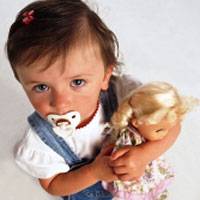
· Do I need to wean the child from the nipples?
After the baby reaches 6 months, it should be weaned. At this time, the nipples, even if orthodontic, begin to appear serious negative factors, so to say side effects:
- baby nipple is addictive;
- if the child continues to suck on a pacifier for up to a year, an abnormal open bite is formed, problems with teething may begin;
- nipple for children inhibits the development of speech;
- sucking dummy can slow down mental development;
- respiratory disorders.
At the age of 6-8 months, consider the use of pacifiers should be particularly careful, we need to wean the child from the nipples. Try to give a pacifier only in extreme cases, and simple children's whims do not apply to them. Remember: before the year you need to wean him from the nipples, by all means!
Now crumbs are teething, his gums are itching, and he pulls into his mouth literally everything, and this is also one of the reasons why it is so difficult to wean the baby from the nipples. Try to switch the baby’s attention to teethers (they are much more important and useful for him now), let them be different in shape, image, color. In everyday life, try to distract the attention of the baby with foreign objects, he begins to perceive the world in all its diversity, so it is not at all difficult to interest the child. Show him a new toy, sing a song, have a laugh together - now everything is new and incredibly interesting for a baby!
Yana Lagidna, specially for the site
And a little more about what is good orthodontic dummy, video:
A small child from birth to one and a half years physiological reasons you need to constantly suck something. It can be a mother’s breast, a finger, a cam or a toy, but most often modern parents use a pacifier for this purpose. From the first time, it is not easy to decide on the best option - first you need to try different options for dummies in order to understand which child is best suited.
With regard to the selection criteria nipples, among them stand out:
- the weight and size of the child - usually soothers are designed for ages 0-6 months (size A or 1), 6-12 months (B or 2) and from 12 to 18 months (C or 3) as the baby grows and its needs change ;
- shape - it can be round, symmetrical, anatomical, and here you need to look at what your kid will enjoy most;
- the size of the holder - it should be big enough, but not too large, not have extra decorations and not irritate the delicate skin of the child;
- safety - the pacifier should not be chipped, broken or broken apart;
- the material is latex or silicone, latex is natural and wears off faster, but synthetic silicone can last for quite a long time;
- manufacturer - after all, well-known brands guarantee the quality of their products, while the little-known cannot guarantee anything to you, so why risk it?
Below we offer you the TOP-10 major manufacturers (brands) of pacifiers, which you can find in the market of children's products. Manufacturer, features, properties, advantages and disadvantages, price - these are the parameters we will touch on in the review.
Nuk Genius - German quality
Nuk Genius is a German-made pacifier. The sucking part has a special ortho-shape - it is slightly flattened and comes with a special indentation, which does not allow the soother to fall out of the baby's mouth. It can shrink, but it does not stick together, three sizes are on sale.
Pros:
- Smart air valve;
- "Healthy" form;
- softness;
- durability;
- materials latex and silicone to choose from.
Minus:
- rather big price
The cost of nipples (average) - 280 rubles.
Pigeon - bet on naturalness
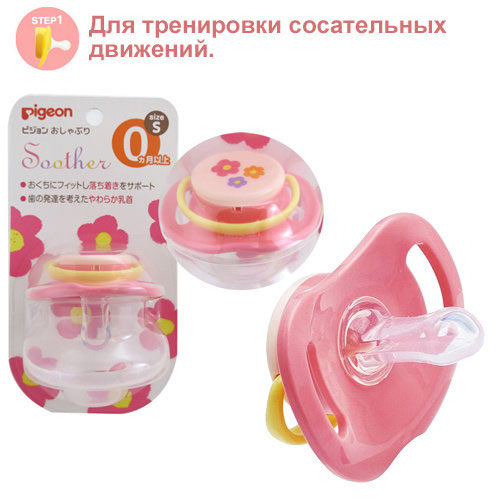
Japanese nipple is intended strictly for newborn babies aged 0-4 months. It has an unusual shape (flattened in the middle part) and is orthodontic. The ideal ratio of price and quality.
Pros:
- inexpensive;
- quality;
- has a beautiful design (designs in the assortment of stars, cars, flowers).
Minuses:
The average cost is 150 rubles.
Philips AVENT - market leader in silicone pacifiers

Classic silicone dummy, which has six holes for ventilation. It is durable, reliable, safe and convenient for the child, because it does not put pressure on the sky.
Benefits:
- always available in pharmacies and stores;
- a huge size range - from birth to three years;
- high quality performance;
- different designs to choose from;
- protective cap included.
Minuses:
- the drop-shaped form is rather difficult to hold in the baby’s mouth;
- moisture can get into the nipples due to ventilation openings;
- the price is still rather big.
The average cost in the Russian Federation is 260 rubles.
HEVEA - high quality latex
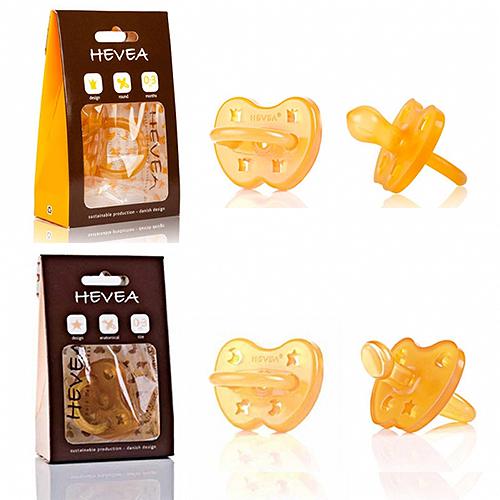
Latex pacifiers HEVEA are among the best on the market in its segment. Raw materials - natural rubber, which provides each nipple with softness, comfortable temperature and hygiene. There are no seams in the construction, therefore it is almost impossible to break it.
Pros:
- solid casting;
- original designs;
- availability of ventilation slots of different shapes;
- all kinds are available - beveled, round, orthodontic;
- 100% natural composition.
Minus:
- high cost.
The average price is 400 rubles.
Original moving nipple Nuby
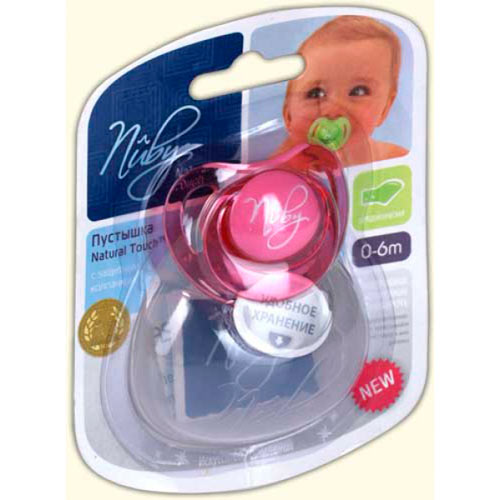
Movable pacifiers Nuby American production will not let the crumbs lazy. The main "trick" of the models is the mobile sucking part, which imitates the mother's breast, makes the baby act and tires, resulting in the child falling asleep faster.
Benefits:
- usability;
- durability;
- the presence of "bumps" on the nipple of silicone, which are well scratched gums;
- three types - anatomical, ortho, "cherry".
Minus:
- the price could have been lower.
The average price is 300 rubles.
Chicco - price and quality

Chicco soft latex soothers are what your baby needs to calm down and fall asleep. They are soft and at the same time elastic, durable and flexible. Latex quickly takes the temperature of the child’s body, making it comfortable for the baby. Chico nipples contribute to the proper formation of bite.
Pros:
- anatomical functional nipple;
- softness and elasticity;
- durable construction that the child does not crack.
Minuses:
- latex remains not very durable material;
- simple design.
The average price in the Russian Federation is 220 rubles.
Bibi cherry silicone - originality above all!

An unusual dummy will definitely appeal to those parents who love original children's things. It is durable, high-quality and has an unusual design. Special two-component silicone is durable and safe. Stand for open nipples and case included.
Pros:
- cherry shape;
- funny inscriptions, vivid pictures that are not erased;
- day and night options;
- swiss quality.
Minuses:
- too small air vents (there are two of them);
- not anatomical shape;
- high cost.
The average cost for the Russian Federation is 300 rubles.
Canpol Babies orthodontist - quality, cheap and great

Polish brand offers really high quality and comfortable anatomical pacifiers inexpensive. Materials to choose from - silicone or latex.
Pros:
- there is an air valve;
- great quality;
- affordable cost;
- there is a cap in the kit;
- a huge selection of designs.
Minuses:
- are missing.
The cost of the Russian Federation - 120 rubles.
TIGEX - advanced technology

Soft latex and silicone pacifiers TIGEX are anatomically shaped, and therefore comfortable for the baby and do not fall out of the mouth. Made from environmentally friendly materials, there are special models for medical purposes for weak children.
Benefits:
- various bright options of execution;
- great quality;
- wide range of models;
- anatomical;
- affordable cost.
Minuses:
The average price is 130 rubles.
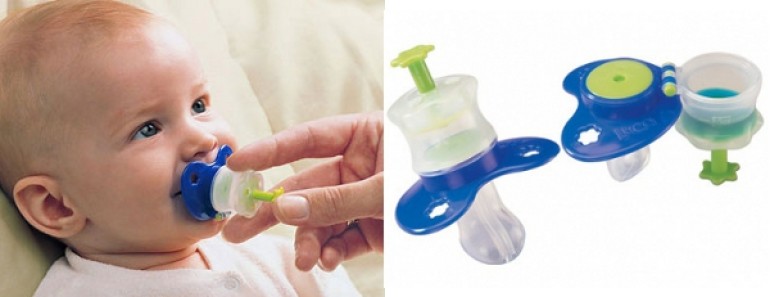
Dummy dispenser is an ideal choice for babies who constantly use the teat. If you need to give the child medicine, pour liquid preparation into the reservoir and give a pacifier to the baby ( read also: how to give the baby medicine in the form of a pill or syrup - ).
Advantages of models:
- the drug is delivered strictly according to its intended purpose and is not lost “on the way”;
- there are piston models;
- two sizes (up to six months and from six months to one and a half years);
- affordable prices;
- ease of use.
Minus:
- the baby will understand that the nipple is not very tasty, which can cause certain difficulties in the future.
Thermometer nipples
I almost forgot, there are also comfortable nipples thermometers for measuring temperature:
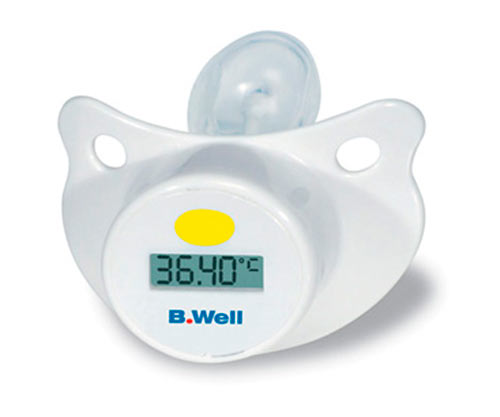
Where can one buy?
Large selection of pacifier in the online store babadu.ru -
How to make a choice?
Focus on your own preferences and, of course, the tastes of the baby, as well as an affordable budget - good, the market has enough quality and not very expensive models. Enjoy the shopping! We read in detail: >>>
Some can not wean the child from the nipples, others can not put the baby in the nipple in the mouth. Yes, yes, sometimes children flatly refuse a pacifier, and quite often it is the nipple soother helps out parents in different situations ... We read in detail about >>>
The time comes when the baby needs to be weaned. Tips on how to wean a child from a pacifier, many mothers hear from grandmothers, neighbors, or just friends. Each of them should not be immediately carried out, each child is already a person with his character and mental stability, therefore, what has come up to one, another can be harmful ... We read in detail about that?how to wean a baby from pacifiers: tips and tricks - \u003e\u003e\u003e
The nipple is a device of a certain form, acting as a substitute for my mother's breast. It helps to satisfy the sucking reflex and helps in feeding the baby. Perhaps such an analogue of the maternal breast - not the best option, but the nipples are still widely used by modern parents around the world.
Types of nipples
Since the appearance of the nipples in the form in which we know it now, manufacturers have tried to make its shape more natural. Modern pacifiers are able to completely imitate a female nipple. In their manufacture using different materialsThey are given the right shape to make the sucking process more comfortable and safe. This allows parents to choose the right dummy that is best for their child.
First of all, all nipples are divided into pacifiers and those used for bottles. Modern substitutes female breast issued for children different ages. They also differ in the material from which they are made and in shape.
Depending on the material used in the manufacture, there are types of nipples such as silicone and latex. Each of them has its advantages and disadvantages.
Depending on the shape, the nipples are orthodontic and anatomical (physiological). The latter are produced in the form of bilateral and round dummy ("cherry"). In addition, each manufacturer, in order to attract a buyer, tries to give its own definition of physiology, and therefore this group can be expanded to infinity. On sale you can meet nightly, soothing, moving nipples, baby pacifiers, performing the function of a thermometer, for the introduction of medicines and inhalations. To buy or not such modern fixtures? It depends on the willingness of parents to experiment and their financial viability.
Which is better: silicone or latex?
Before you opt for the nipple you like, you should carefully study the properties of the material from which it is made. But regardless of this, any dummy must comply with established safety standards and must not contain toxic and other hazardous substances.
If you take into account the material used in the production, there are the following types of nipples for children:
- latex;
- silicone.
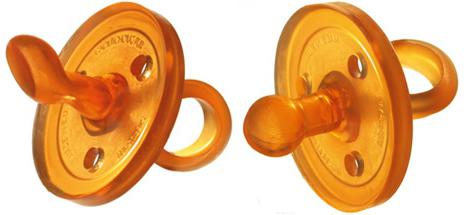
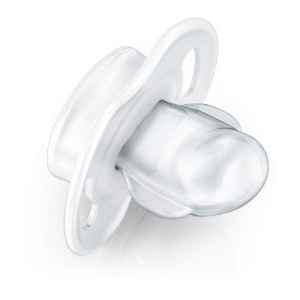
However, such a dummy has a specific flat shape, different from the female nipple. That is why often she does not like kids.
Although pediatricians agree with dentists, they still recommend buying anatomically shaped pacifiers. But different manufacturers see the female nipple in their own way. Therefore, there are such types of nipple physiological forms, as bilateral, always occupying correct position mouth, drop-shaped and round (“cherry”).
Criteria for choosing a baby's dummy
To make it easier for parents to choose the nipples, the main criteria were prepared:
- Dummy must match the age of the child. Too soft nipples are not suitable for children who have already cut their teeth, because babies easily gnaw them.
- The base of the nipple should have openings so that saliva does not accumulate under it and the skin breathes, and a notch for the nose does not obstruct breathing.
- It is better to give preference to so-called well-known companies. They offer different types of baby nipples that meet all safety requirements.
- Latex soothers have a short They are recommended to be replaced every 4-6 weeks.
- Before you give the nipple to the baby, you should make sure that it is intact, has a smooth surface without irregularities.
- Any, even the most expensive dummy before boiling should be boiled for 2-3 minutes.
How to choose a pacifier for a bottle
Choosing a nipple for a bottle is somewhat different from buying a pacifier. They are made in the same way from silicone or latex, mainly have a physiological form, imitating the mother's breast, and are selected in accordance with the age of the child.
Depending on the size, there are the following types of nipples for bottles:
- 0-6 months;
- 6-18 months;
- 18-36 months.
In addition, the bottle teats have a different number of holes, from one to three. Which one is better to choose depends on what kind of food they are supposed to use. For milk or water, one hole in the nipple is suitable, and for porridge - two or three holes.

Modern manufacturers pay special attention to the health and safety of their young customers. Often, babies, mostly up to three months, in the process of feeding, swallow air, which is why they occur. In order to prevent this unpleasant phenomenon, nipples with anti-colic effect are released. And so that the child could suck the bottle continuously and not choke with food, nipples with an air valve inside were created. The mechanism of its action is based on the fact that when the baby starts to suck, the valve opens, and when it stops - it closes.
Dummy: harm or benefit?
The main positive point from using a pacifier is that the child calms down and satisfies the sucking reflex. But not all children need it, especially if the mother is nearby and can always offer a breast. Therefore, the benefits of dummy rather obvious to parents who can briefly stay in silence and go about their business. But prolonged sucking can have a negative effect on the baby’s health.
Despite the fact that manufacturers offer the most diverse types of pacifier, the harm from their use is obvious:
- When sucking a pacifier, air is swallowed. As a result, the child has intestinal colic.
- With prolonged use of the pacifier, the baby gets tired to suck, and when it comes to feeding, he refuses to take the breast.
- Pacifiers contribute to the formation and lead to the deformation of the teeth.
- When using the nipple is difficult to achieve hygienic cleanliness. Often, despite all preventive measures, it is a source of vital activity of harmful microorganisms.
- Long sucking a pacifier causes dependence on it and entails difficulties in further weaning.
When to wean a child from the nipples?
Often parents have a question about when to give a pacifier and when to wean a child from it. In the first case, the answer will be ambiguous. The sucking reflex in a child is most strongly developed at the age of three months. But you need to look at the child. If he is restless, trying to suck on a diaper or nearby objects, then a dummy is needed. Some babies are so demanding that parents, having tried all existing types of nipples, cannot find a suitable option. In this case, it is not necessary to insist, but it is better to try to look for alternative ways to calm the child.

As for weaning from a pacifier - the best option is to gradually remove the pacifier after six months. And then by the first birthday of the baby he will be able to do without her, while not having time to cause significant harm to his forming teeth. Otherwise, by the age of one and a half, the child will have a strong dependence on the pacifier and the weaning process will be delayed for a long time.
Nipple offers for baby bottles on the market are large, so you should carefully analyze them and choose the nipple you need for current needs. It is the choice of the appropriate nipples often determines the success of feeding.
The nipple for the bottle should imitate the female breast as accurately as possible, then the sucking movements of the baby when feeding from such a nipple will be almost the same as when breastfeeding.
Material nipples for baby bottles.
Depending on the material, you can choose two types of nipples for bottles: latex (rubber) and silicone.
Latex teats (rubber nipples) are yellowish and smell rubber. Their advantage over silicone nipples is their softness, and at the same time this is their disadvantage - they often stick together during feeding. Latex is not durable material and quickly darkens under the action of sunlight. These nipples need to be replaced often enough with new ones.
Attention! Although latex is a natural material, an allergic reaction is possible when using latex nipples.
Silicone nipples Made from high quality medical grade silicone. They are colorless, transparent, have no smell and taste. They are a little harder than latex, but because of this they are more durable and less susceptible to sunlight. The main thing is that silicone nipples do not change the taste of food and do not cause an allergic reaction.
Tip: If you combine breast-feeding and bottle feeding, use silicone nipples.
Nipple shape for baby bottles.
In their form, bottle nipples are of three types: anatomical, standard, and bottle neck nipples with a wide neck.
 Anatomical nipple (orthodontic nipples) corresponds to the anatomical structure of the baby's mouth.
Anatomical nipple (orthodontic nipples) corresponds to the anatomical structure of the baby's mouth.
 Standard nipple (ordinary nipple) has a simple oblong shape - a narrow base and a long nipple.
Standard nipple (ordinary nipple) has a simple oblong shape - a narrow base and a long nipple.
Important! Standard nipples are not suitable for wide-necked bottles.
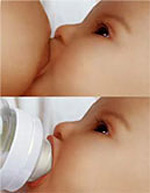 Wide Neck Baby Teat the shape is most close to the contours of the female breast - a broad base and a small nipple. As a rule, the baby takes the breast with its mouth wide open, covering the nipple and areola, therefore, the nipple for bottles with a wide neck ensures the correct technique of capture. When feeding from such nipples, the baby’s sucking movements will be exactly the same as when breastfeeding.
Wide Neck Baby Teat the shape is most close to the contours of the female breast - a broad base and a small nipple. As a rule, the baby takes the breast with its mouth wide open, covering the nipple and areola, therefore, the nipple for bottles with a wide neck ensures the correct technique of capture. When feeding from such nipples, the baby’s sucking movements will be exactly the same as when breastfeeding.
Tip: If you combine breastfeeding and bottle feeding, use these particular nipples.
Now let's talk about the intensity of the flow of food.
Intensity of food flow varies with the age of the child and his appetite. In nipples, the intensity of the flow is regulated by the size of the hole or their number. In some nipples, punching is done with a laser, which allows you to clearly control its diameter, and hence the flow rate.
Nipples for newborns (up to two to three months) usually have one hole. The diameter of the hole in the nipple is so small that the child makes the same effort as when sucking from the mother's breast.
Nipples with two holes ( slow flow), usually recommended for children aged two to three months.
From three months it is possible to use a nipple with three holes. (average flow).
 From three to four months of life it is convenient to use the nipples with variable flow. This nipple has one hole of a special shape (in the form of a slot) and allows you to adjust the flow rate during the feeding process. On the side surface of this nipple there are risks (I, II, III) or figures corresponding to the intensity of the flow (slow-medium-fast). By turning the nipple of one side or another to the baby’s nose, you can adjust the flow rate from the bottle. In addition, this nipple is ideal for thicker than milk, food - for fruit juices with pulp, thick mixes, kefir, porridge.
From three to four months of life it is convenient to use the nipples with variable flow. This nipple has one hole of a special shape (in the form of a slot) and allows you to adjust the flow rate during the feeding process. On the side surface of this nipple there are risks (I, II, III) or figures corresponding to the intensity of the flow (slow-medium-fast). By turning the nipple of one side or another to the baby’s nose, you can adjust the flow rate from the bottle. In addition, this nipple is ideal for thicker than milk, food - for fruit juices with pulp, thick mixes, kefir, porridge.
With six months and older, you can use the teat with four holes ( fast flow).
Tip: From six months, so that your baby can learn to drink from a cup, instead of the nipple, you can use the nipple.
Important! Never increase the hole and their number by yourself.
Anti-vacuum skirt (air valve).
 A common problem when feeding from a bottle is aerophagy - swallowing air. When using a normal nipple, a vacuum is created in the bottle during feeding and the nipple simply sticks together under the pressure of the surrounding air. In such cases, feeding has to be interrupted from time to time, taking the nipple out of the baby’s mouth, and waiting for the air to get into the bottle through the nipple opening and the nipple is again flattened. At such moments, looking up from the nipples, the baby swallows air. Aerophagia is considered one of the causes of regurgitation and intestinal colic in children during the first months of life. In order to reduce the likelihood of aerophagy during bottle feeding, an anti-vacuum skirt (air valve) was developed, which ensures a constant flow of air into the bottle through special nipple valves that opens and closes in the natural rhythm of baby's sucking.
A common problem when feeding from a bottle is aerophagy - swallowing air. When using a normal nipple, a vacuum is created in the bottle during feeding and the nipple simply sticks together under the pressure of the surrounding air. In such cases, feeding has to be interrupted from time to time, taking the nipple out of the baby’s mouth, and waiting for the air to get into the bottle through the nipple opening and the nipple is again flattened. At such moments, looking up from the nipples, the baby swallows air. Aerophagia is considered one of the causes of regurgitation and intestinal colic in children during the first months of life. In order to reduce the likelihood of aerophagy during bottle feeding, an anti-vacuum skirt (air valve) was developed, which ensures a constant flow of air into the bottle through special nipple valves that opens and closes in the natural rhythm of baby's sucking.
Some nipples instead of valves have microscopic holes located on the sides of the nipples.
Tip: In the absence of nipples with anti-vacuum skirt, to avoid intestinal colic in children, use anti-colic bottles.
Important! Not all nipples have an anti-vacuum skirt (air valve) or have air inlets.
Remember! Latex nipples should be changed once every 2-3 weeks, and silicone - 3 months. Carefully inspect and check the nipple before each feeding (pull it in all directions). If you find damage to your nipple, throw it away immediately. Do not use the bottle nipple as a pacifier.
The article was prepared using information materials from well-known leading companies in the market of goods for mothers and babies, and the personal experience of the author of the article.
